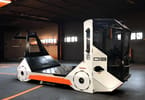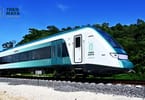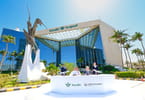Red balloons, a proud president Recep Tayyip Erdoğan, Prime Minister Binali Yıldırım and foreign guests witnessed the opening of Yavus Sultan Selim Bridge in Istanbul on Friday.
Putting all differences besides, it was a celebration of a special kind.
Driving from Europe to Asia is now possible on three different bridges in Istanbul, Turkey. Crossing the Bosporus is an amazing experience for every tourist visiting Istanbul.
According to the Anadolu Agency, the bridge, built over the Bosporus strait as part of the North Marmara Highway project, will be the world’s largest suspension bridge. It will be the second one to be operated by the private sector.
The bridge, which cost $3 billion, has a total of 10 lanes – eight highway lines and two rail lines running in both directions, and is located on the 148-kilometer-long Odayeri-Paşaköy section of the project.
The 59-meter-wide bridge measures 164 meters from end to end and has 322-meter-high bridge towers. It will be a first in the world as it includes a rail system on the same level. The bridge, which is 1,408 meters over the Bosporus, will be the longest suspension bridge in the world with a rail system.
The bridge is expected to alleviate traffic in Istanbul and eliminate air pollution and environmental problems arising from urban traffic. Thus, it will help save nearly $1.45 billion for energy and $335 million in labor force loss a year, an annual economic loss of $1.785 billion.
Meanwhile, construction work on the 169-kilometer-long Kurtköy-Akyazı section and 88-kilometer-long Kınalı-Adayeri section, both parts of the North Marmara Highway Project, has started. Amounting to 257 kilometers in total, the roads should be finished by the end of 2018, bringing the entire North Marmara Highway into service at that time.
The bridge is the third to connect the Asian and European sides of Istanbul over the Bosporus strait. The fee for automobiles starts at TL 9.90 and for heavy-tonnage vehicles starts at TL 13.20, and will be calculated according to wheelbases and wheel numbers. Passing from the Asian side to the European side is free of charge, but the reverse route will incur these fees. The current fees are in place until Jan. 2, 2017. The fee for the bridge’s link roads will be TL 0.24 per kilometer. Vehicles have to pay an additional TL 0.24 per kilometer, depending on the distance that they cover on the junctions while exiting the bridge. All link roads, from Odayeri to the Mahmutbey toll booths have been completed on the European side. It is possible to enter and exit the bridge through Riva, Çamlık, Paşaköy and Kurtköy on the Asian side. With the bridge coming into service, heavy vehicles will start passing through the Yavuz Sultan Selim Bridge instead of the Fatih Sultan Mehmet Bridge.
WHAT TO TAKE AWAY FROM THIS ARTICLE:
- It will be a first in the world as it includes a rail system on the same level.
- According to the Anadolu Agency, the bridge, built over the Bosporus strait as part of the North Marmara Highway project, will be the world’s largest suspension bridge.
- The bridge, which is 1,408 meters over the Bosporus, will be the longest suspension bridge in the world with a rail system.






















